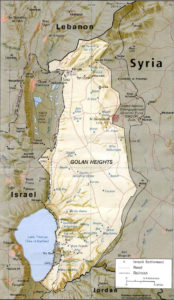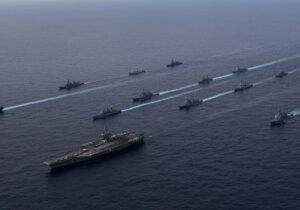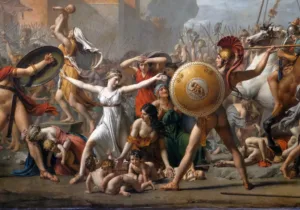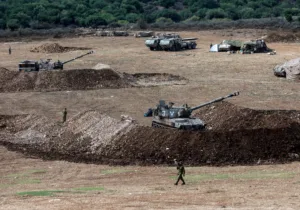President Trump tweeted last Thursday, “After 52 years it is time for the United States to fully recognize Israel’s Sovereignty [sic] over the Golan Heights, which is of critical strategic and security importance to the State of Israel and Regional Stability [sic]!’” On Monday, during a visit to Washington by Israeli Prime Minister Benjamin Netanyahu, Trump signed a proclamation formally recognizing Israel’s annexation of the Golan Heights.
Here is what you should know about the Golan Heights:

1. The Golan Heights (or Golan) is a 700 square mile area of land in the Middle East. The Golan is bounded by the Jordan River and the Sea of Galilee on the west, Mount Hermon on the north, a branch of the Yarmūk River on the east, and the Yarmūk River on the south. The Golan extends about 44 miles from north to south and, at its widest point, about 27 miles from east to west.
2. In the Bible, land now known as the Golan Heights was referred to as Bashan. The word Golan appears to be derived from the biblical city of “Golan in Bashan,” first mentioned in Deuteronomy 4:43 and Joshua 21:27. This land was given to the half-tribe of Manasseh (Joshua 13:29-31), and the town of Golan became a “city of refuge” (Joshua 21:27). The land of Bashan is also mentioned in Genesis 14:5; 1 Kings 4:13; 2 Kings 10:33, 13:25; Psalms 22:12; Isaiah 2:13; Jeremiah 50:19; Ezekiel 27:6, 39:18; Amos 4:1; and Zechariah 11:2.
3. The Golan was conquered by the Ottoman Empire in the sixteenth century, where it remained an Ottoman eyalet (an administrative division). After the division of the Ottoman Empire following World War I, the League of Nations’ Mandate for Syria and Lebanon put the Golan (along with Syria) under the control of France. When the French mandate ended in 1943, the Golan became part of the sovereign state known as the Syrian Republic.
4. Following the creation of the State of Israel and the 1948 Arab–Israeli War, an armistice agreement was signed between Syria and Israel. A commission of the United Nations, the Israel–Syria Mixed Armistice Commission (ISMAC), was tasked with overseeing a special demilitarized zone (DMZ) between the countries that ran through the Golan.
5. Despite the armistice, Syrians used the Golan as a regular base of attack on the Jewish nation. From 1948 to 1967, Syrian artillery located in the Golan regularly shelled the northern areas, including the Huleh Valley, Israel’s richest agricultural area. The Syrian government also allowed attacks to be carried out by Yasir Arafat’s Palestinian National Liberation Movement, a group now known as Fatah. Despite repeated appeals to the UN, the international body refused to prevent—or even condemn—the terrorist attacks.
6. During the Six-Day War of 1967, Israel seized about two-thirds of the Golan from Syria. After the conflict, an armistice line was established yet again, but this time the region was under Israeli military control. Syria tried to retake the Golan during the 1973 Middle East war. But despite inflicting heavy losses on Israeli forces, the surprise attack was thwarted and the Israelis retained control. In 1974, both countries signed an armistice, and yet another UN observer force was put in place to monitor the ceasefire.
7. After the ceasefire in 1967, the UN Security Council issued Resolution 242, which was introduced by the United Kingdom and supported by the United States. The resolution affirmed in its preamble “the inadmissibility of the acquisition of territory by war,” and then called on “withdrawal of Israel armed forces from territory occupied in the recent war.” Since then Israel has repeatedly expressed a willingness to consider returning the Golan as part of a peace agreement with Syria. Every Israeli prime minister except Ariel Sharon engaged in talks with Syria’s leaders about ending their conflict. But since Syria’s civil war in 2011, the peace talks have remained at an impasse.
8. Since 1967 the Golan region has become an area of strategic and economic importance for Israel. The heights provide a direct line of sight on the Syrian capital of Damascus and allow a prime vantage point for monitoring Syrian troop movements. The region also supplies Lake Kinneret (the Sea of Galilee), which provides about a third of the water for Israel. The economy of the Golan is based on agriculture, industry, and tourism, and is home to Israel’s only ski resort.
9. Israel began to settle the Golan soon after the 1967 ceasefire. Currently, there are more than 33 Jewish settlements on the heights, with an estimated 20,000 settlers. An additional 26,000 Syrians, most of them members of the Druze sect, also live in the region.
10. In 1981, Israeli Prime Minister Menachem Begin pushed a measure through Parliament to annex the Golan. At the time it was the first change in Israel’s frontiers since 1967, when East Jerusalem and an adjoining part of the West Bank were annexed. The Reagan administration opposed the annexation, as did Syria, Egypt, and the Soviet Union. The annexation was not recognized by any nation until this past Monday when President Trump signed his proclamation.
Joe Carter is an adjunct professor of journalism at Patrick Henry College, an editor for several organizations, and the author of the NIV Lifehacks Bible.
Photo Credit: President Donald Trump, joined by Vice President Mike Pence and Israeli Prime Minister Benjamin Netanyahu, signs a proclamation formally recognizing Israel’s sovereignty over the Golan Heights on Monday, March 25, 2019, in the Diplomatic Reception Room of the White House. Official White House photo by Shealah Craighead.







 Sponsor a student for Christianity & National Security 2024
Sponsor a student for Christianity & National Security 2024